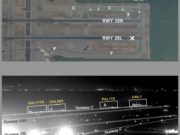News, Runway Safety (approach and landing), Accident/Incident Investigation
Business Jet Lined Up with Occupied Taxiway
GIV on approach to Philadelphia overflew four airliners during go-around, NTSB says.
Viewing 1 - 4 of 4 results
News, Runway Safety (approach and landing), Accident/Incident Investigation
GIV on approach to Philadelphia overflew four airliners during go-around, NTSB says.
by FSF Editorial Staff

News, Runway Safety (approach and landing), Accident/Incident Investigation
The image at top shows the configuration of Runways 28L and 28R, and Taxiway C…
by FSF Editorial Staff
News, Runway Safety (approach and landing), Accident/Incident Investigation
Pilots initiated go-around at decision height.
by FSF Editorial Staff

News, Runway Safety (approach and landing), Accident/Incident Investigation
Air Canada A320 got as low as 59 ft above ground level before go-around
by FSF Editorial Staff
